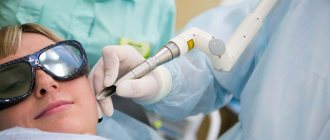Laser mole removal is a procedure that is quickly tolerated by the patient. The main advantage is a good cosmetic result. Depending on the type of mole being removed, different lasers may be used. Whether mole removal will be effective and what the cosmetic result will be after healing depends on the experience of the doctor and the chosen laser.
Of all mole removal methods, laser removal provides the best patient reviews. Especially when removing moles from the face, when the most cosmetic result is important. The procedure is painless (performed under local anesthesia), fast, and causes minimal discomfort. Laser procedures do not limit the patient’s daily activity - frequent dressings are not required, local disinfection is sufficient.
How are moles removed with laser?
The content of the article
The procedure is carried out under local anesthesia - before removing the mole, the doctor administers local analgesics. The effect of the drug lasts from half an hour to 3 hours. After the procedure, a wound remains, which, depending on the size and location of the removed mole, heals in 2-4 weeks.
After the procedure for removing the bandage, the doctor writes a prescription for an ointment, which must be used at home until healing. This prevents infection and provides a beautiful aesthetic appearance and helps prevent scarring. Depending on the size and location of the mole, the procedure takes 10-15 minutes, and several moles can be removed in one visit.
The laser, which is used to remove moles or other skin lesions, works on the principle of evaporating water from cells. This means that water evaporates from the affected cells and the cells die, while the surrounding tissue remains intact. True, in some cases, a post-procedure wound on the skin caused by heating may seem deeper than it actually is, but after a few days everything returns to normal, and the skin defect fills in during the healing period and leaves a small spot.
The effect of laser on moles
The surgical laser used for mole removal (and other soft tissue procedures) is highly accurate and is by far the best choice for this type of procedure.
Symptoms of degeneration
Signals for the transformation of a nevus into a cancerous tumor can be as follows:
- bleeding;
- peeling, cracking of the skin;
- the appearance of compactions, nodules;
- the appearance of volume (the mole begins to rise above the skin);
- unpleasant sensations in the nevus area (pain, burning, itching).
If these signs appear, it is necessary to check moles for cancer.
Oncology specialists will conduct a full examination of the skin, including moles that cause concern. At the medical center, diagnostic activities are carried out using modern equipment. We are located at: Moscow, 2nd Tverskoy-Yamskaya lane, 10. You can make an appointment using the feedback form or by phone.
Removal and treatment of moles with laser
After laser removal of a mole and to achieve the best cosmetic result until the wound heals, it is recommended to follow these recommendations:
- Avoid UV rays (and when unavoidable, use sunscreen with at least SPF 30, preferably SPF50). If the patient tans during healing, there is a high likelihood of post-inflammatory pigmentation, which can make the area where the procedure was performed more visible;
- Do not go to solariums, saunas, swimming pools, or engage in vigorous physical exercise (to avoid infections and injuries).
- As the wound heals, dry scabs form and act as a natural dressing to prevent infection. These scabs should not be scratched or otherwise torn off - wait until they fall off on their own.
During the procedures prescribed by the doctor - disinfection and dressing - the wound heals well and no infectious (or other complications) arise. Once the wound has healed, redness persists and sometimes it takes 1 to 2 months for the area of skin to reach its final appearance after the procedure. If the initial scabs have fallen off and there is an increased risk of scarring, a special scar treatment cream can be applied.
The main measures that are recommended for the treatment of scars formed after laser mole removal are as follows:
- Special purpose creams with silicone and so on.
- Special patches with silicone.
Silicone patch for scar treatment
Laser removal of tumors. How to properly care for your skin after the procedure?
The patient must understand that after surgery, the skin at the removal site may change noticeably.
Stages of wound healing:
- 1 Week
At the site where the papilloma was removed, an open small wound will first appear, which will quickly become covered with a thin crust. There is no need to peel off the crust, as it protects against infection from entering an open wound. It is necessary to protect the place where the wound is located from damage and injury. Do not rub the affected area with a washcloth. Do not scratch the damaged area under any circumstances.
According to the recommendations of a specialist, you can treat the wound with disinfectants.
- 2 week
Literally after 10 days the crust will disappear, and a barely noticeable scar will form in its place. Don't be afraid that this scar will stay with you forever! It will disappear over time, and the skin on the operated area will completely recover.
- 3 week
During this period of time, healthy skin develops at the site of the wound, which is able to independently withstand ultraviolet rays and other factors.
Once the wound where there was previously a tumor has completely healed, no further special care is needed.
If you suddenly feel itching at the operated site (after 20 days), but the skin looks normal, without redness and inflammation, you can use an ointment with a soothing effect.
By the end of the month after the procedure, the dimple from the removed tumor is smoothed out. At 3 months, a barely noticeable trace of the operation remains on the skin.
The healing process takes two to four weeks. The period will depend on the area occupied by the removed tumor. The larger the area of removal, the longer the process of tissue regeneration in the damaged area will be.
Let's move on to the issue of proper care after removal of tumors, so that this leads to a rapid healing process and regeneration of the skin without negative consequences.
To do this, consider a few rules that should be followed:
- For the first few days, do not wet the wound where there was previously a tumor.
- After laser removal, the skin should not be exposed to ultraviolet rays. You should avoid visiting the solarium and staying in the sun for long periods of time. Neglecting this rule can result in scar pigmentation.
- You should use sunscreen for a month after the procedure.
- It is worth giving up scrubs, lotions and tonics if you have removed a mole on your face. It will also be undesirable to use foundation and cosmetics for 2 weeks after the procedure.
- It is forbidden to drink alcohol during the week, as it causes blood vessels to dilate, which can cause bleeding;
- Do not allow household chemicals to come into contact with the operated area.
- It is not recommended to visit saunas and swimming pools for the first couple of weeks to reduce the risk of infection in the place where the tumor was;
- If the tumor has been removed in the genital area, you need to avoid intimacy for a while.
If you adhere to the simplest rules, the recovery process will be rapid and without unpleasant consequences.
Important! If, a couple of days after the laser tumor removal procedure, swelling or bleeding is observed in the wound area, you should immediately consult your doctor, since these symptoms may indicate the development of an infection.
Is it possible to remove all moles with laser?
During the consultation, when a patient requests removal of a mole, the doctor carefully examines the mole and selects the most suitable removal method. If the mole has no lesions and dermatoscopy or siascopy does not reveal signs of atypia, removal for medical purposes is not required.
In this case, the removal of a mole is carried out only when the patient wishes it for aesthetic or comfort reasons, and in each case the method of removing a specific mole is selected individually. However, even unchanged moles are recommended to be removed if they are often injured by clothing, jewelry, shaving, and so on.
Moles are usually removed with a laser after administration of local analgesics. Laser mole removal is a quick procedure and the wound heals faster than surgical removal as there are no stitches, so a better cosmetic result is achieved. In addition, the likelihood of postoperative complications is much lower.
Can a mole develop into cancer?
A healthy mole does not turn into a cancerous tumor without prerequisites. If the nevus is constantly injured, the risk of its degeneration into a malignant formation increases. Removing moles on your own can lead to cancer. Careless shaving and injuries from fasteners can lead to the transformation of a mole into skin cancer.
But the most dangerous enemy of a healthy nevus is considered to be excess sunlight. Short-term but intense exposure to ultraviolet radiation increases the risk of uncontrolled division of melanocytes. According to statistics, those with light hair and skin are also at risk and should have their moles checked for cancer more often.
People with relatives who have ever suffered from melanoma or other cancer diseases often develop alarming symptoms.
Some people who like to visit beauty salons believe that moles are “unaesthetic.” In salons, specialists perform mole removal, declaring that this is a harmless procedure, but in fact, such removal can lead to cancer.
The malignant degeneration of a mole into skin cancer is called malignancy.
5. How many days does it take for a wound to heal after a mole is removed?
After removal, a dry crust remains on the skin. This is coagulated tissue. Underneath, healing and restoration of the skin begins to take place. After 7-10 days, this crust falls off on its own. Under no circumstances should you tear it off prematurely. The primary formed scar after the scab has fallen off is still different from the surrounding tissue. Regeneration processes continue in it and complete restoration of the structure ends by the 20th day. The area may still differ in color from the surrounding tissue, since the pigment accumulated in the cells is not equally distributed. But after a month it will be impossible to distinguish the place where the removal took place.
Scenario three – a mistake by the pathologist
A mole was removed; according to histology, it was a nevus, but skin cancer developed at the site of removal.
It is human nature to make mistakes - this was noted by the ancient Romans. Doctors are people too and can make mistakes too. Neither a therapist, nor a surgeon, nor even a pathologist is immune from mistakes. What can a doctor do to avoid mistakes? If in doubt, consult with colleagues. If necessary, from other institutions. Unfortunately, not all laboratories have the technical capabilities for this.
How to avoid becoming a victim of the third scenario?
- Be careful when choosing a laboratory.
- If there are any doubts about the result of the study, take the material and take it for review to another laboratory, or even two others. Don’t be afraid to send it to laboratories in the capital by courier.
You might be thinking, “How terrible! You can't trust anyone and you can't be sure of anything! There’s no way I’m going to remove a mole that bothers me so much, it’s better and safer to deal with it...”
Don't give in to neurosis. Human error can lie in wait anywhere, and you can never be 100% immune to it. The laboratory doctor may do the analysis incorrectly, and we will not know that we are sick and will not begin timely treatment. A radiologist or ultrasound doctor may make a mistake when conducting a study, and the consequences of such a mistake will also be very sad. A builder can drop a brick on our head, a car can hit us on the street - there are a huge number of chances to go to another world. However, it is not worth developing hypochondria and depression on this basis, because if you follow the logic of maximum reinsurance to the end, it is better to stay at home and never go out J











